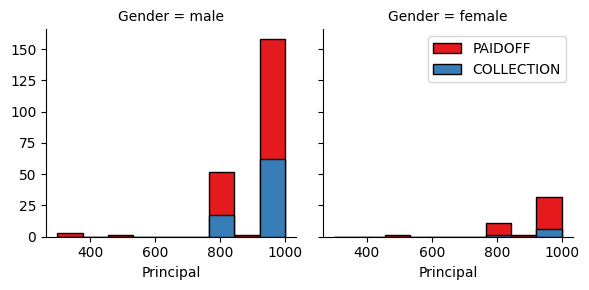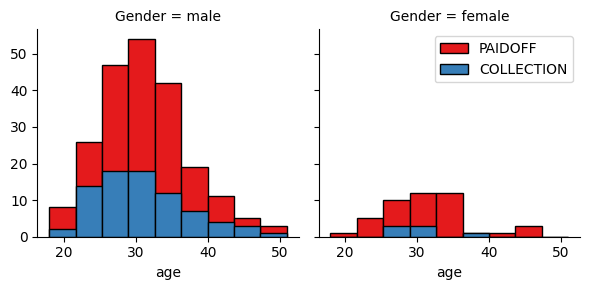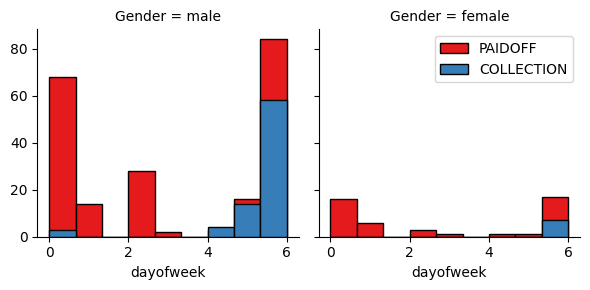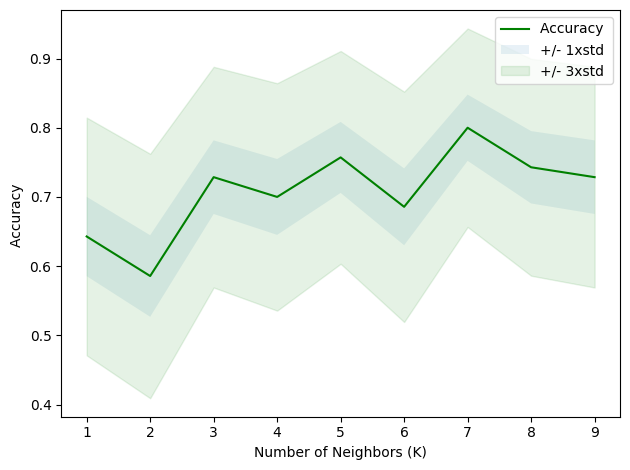Classification with Python
In this notebook we try to practice all the classification algorithms that we have learned in this course.
We load a dataset using Pandas library, and apply the following algorithms, and find the best one for this specific dataset by accuracy evaluation methods.
Let’s first load required libraries:
import itertools
import numpy as np
import matplotlib.pyplot as plt
from matplotlib.ticker import NullFormatter
import pandas as pd
import numpy as np
import matplotlib.ticker as ticker
from sklearn import preprocessing
%matplotlib inline
About dataset
This dataset is about past loans. The Loan_train.csv data set includes details of 346 customers whose loan are already paid off or defaulted. It includes following fields:
| Field | Description |
|---|---|
| Loan_status | Whether a loan is paid off on in collection |
| Principal | Basic principal loan amount at the |
| Terms | Origination terms which can be weekly (7 days), biweekly, and monthly payoff schedule |
| Effective_date | When the loan got originated and took effects |
| Due_date | Since it’s one-time payoff schedule, each loan has one single due date |
| Age | Age of applicant |
| Education | Education of applicant |
| Gender | The gender of applicant |
Let’s download the dataset
!wget -O loan_train.csv https://cf-courses-data.s3.us.cloud-object-storage.appdomain.cloud/IBMDeveloperSkillsNetwork-ML0101EN-SkillsNetwork/labs/FinalModule_Coursera/data/loan_train.csv
--2023-01-26 13:26:05-- https://cf-courses-data.s3.us.cloud-object-storage.appdomain.cloud/IBMDeveloperSkillsNetwork-ML0101EN-SkillsNetwork/labs/FinalModule_Coursera/data/loan_train.csv
Resolving cf-courses-data.s3.us.cloud-object-storage.appdomain.cloud (cf-courses-data.s3.us.cloud-object-storage.appdomain.cloud)... 169.63.118.104
Connecting to cf-courses-data.s3.us.cloud-object-storage.appdomain.cloud (cf-courses-data.s3.us.cloud-object-storage.appdomain.cloud)|169.63.118.104|:443... connected.
HTTP request sent, awaiting response... 200 OK
Length: 23101 (23K) [text/csv]
Saving to: ‘loan_train.csv’
loan_train.csv 100%[===================>] 22,56K --.-KB/s in 0,001s
2023-01-26 13:26:06 (28,9 MB/s) - ‘loan_train.csv’ saved [23101/23101]
Load Data From CSV File
df = pd.read_csv('loan_train.csv')
df.head()
| Unnamed: 0.1 | Unnamed: 0 | loan_status | Principal | terms | effective_date | due_date | age | education | Gender | |
|---|---|---|---|---|---|---|---|---|---|---|
| 0 | 0 | 0 | PAIDOFF | 1000 | 30 | 9/8/2016 | 10/7/2016 | 45 | High School or Below | male |
| 1 | 2 | 2 | PAIDOFF | 1000 | 30 | 9/8/2016 | 10/7/2016 | 33 | Bechalor | female |
| 2 | 3 | 3 | PAIDOFF | 1000 | 15 | 9/8/2016 | 9/22/2016 | 27 | college | male |
| 3 | 4 | 4 | PAIDOFF | 1000 | 30 | 9/9/2016 | 10/8/2016 | 28 | college | female |
| 4 | 6 | 6 | PAIDOFF | 1000 | 30 | 9/9/2016 | 10/8/2016 | 29 | college | male |
df.shape
(346, 10)
Convert to date time object
df['due_date'] = pd.to_datetime(df['due_date'])
df['effective_date'] = pd.to_datetime(df['effective_date'])
df.head()
| Unnamed: 0.1 | Unnamed: 0 | loan_status | Principal | terms | effective_date | due_date | age | education | Gender | |
|---|---|---|---|---|---|---|---|---|---|---|
| 0 | 0 | 0 | PAIDOFF | 1000 | 30 | 2016-09-08 | 2016-10-07 | 45 | High School or Below | male |
| 1 | 2 | 2 | PAIDOFF | 1000 | 30 | 2016-09-08 | 2016-10-07 | 33 | Bechalor | female |
| 2 | 3 | 3 | PAIDOFF | 1000 | 15 | 2016-09-08 | 2016-09-22 | 27 | college | male |
| 3 | 4 | 4 | PAIDOFF | 1000 | 30 | 2016-09-09 | 2016-10-08 | 28 | college | female |
| 4 | 6 | 6 | PAIDOFF | 1000 | 30 | 2016-09-09 | 2016-10-08 | 29 | college | male |
Data visualization and pre-processing
Let’s see how many of each class is in our data set
df['loan_status'].value_counts()
PAIDOFF 260
COLLECTION 86
Name: loan_status, dtype: int64
260 people have paid off the loan on time while 86 have gone into collection
Let’s plot some columns to underestand data better:
# notice: installing seaborn might takes a few minutes
!conda install -c anaconda seaborn -y
zsh:1: command not found: conda
import seaborn as sns
bins = np.linspace(df.Principal.min(), df.Principal.max(), 10)
g = sns.FacetGrid(df, col="Gender", hue="loan_status", palette="Set1", col_wrap=2)
g.map(plt.hist, 'Principal', bins=bins, ec="k")
g.axes[-1].legend()
plt.show()

bins = np.linspace(df.age.min(), df.age.max(), 10)
g = sns.FacetGrid(df, col="Gender", hue="loan_status", palette="Set1", col_wrap=2)
g.map(plt.hist, 'age', bins=bins, ec="k")
g.axes[-1].legend()
plt.show()

Pre-processing: Feature selection/extraction
Let’s look at the day of the week people get the loan
df['dayofweek'] = df['effective_date'].dt.dayofweek
bins = np.linspace(df.dayofweek.min(), df.dayofweek.max(), 10)
g = sns.FacetGrid(df, col="Gender", hue="loan_status", palette="Set1", col_wrap=2)
g.map(plt.hist, 'dayofweek', bins=bins, ec="k")
g.axes[-1].legend()
plt.show()

We see that people who get the loan at the end of the week don’t pay it off, so let’s use Feature binarization to set a threshold value less than day 4
df['weekend'] = df['dayofweek'].apply(lambda x: 1 if (x>3) else 0)
df.head()
| Unnamed: 0.1 | Unnamed: 0 | loan_status | Principal | terms | effective_date | due_date | age | education | Gender | dayofweek | weekend | |
|---|---|---|---|---|---|---|---|---|---|---|---|---|
| 0 | 0 | 0 | PAIDOFF | 1000 | 30 | 2016-09-08 | 2016-10-07 | 45 | High School or Below | male | 3 | 0 |
| 1 | 2 | 2 | PAIDOFF | 1000 | 30 | 2016-09-08 | 2016-10-07 | 33 | Bechalor | female | 3 | 0 |
| 2 | 3 | 3 | PAIDOFF | 1000 | 15 | 2016-09-08 | 2016-09-22 | 27 | college | male | 3 | 0 |
| 3 | 4 | 4 | PAIDOFF | 1000 | 30 | 2016-09-09 | 2016-10-08 | 28 | college | female | 4 | 1 |
| 4 | 6 | 6 | PAIDOFF | 1000 | 30 | 2016-09-09 | 2016-10-08 | 29 | college | male | 4 | 1 |
Convert Categorical features to numerical values
Let’s look at gender:
df.groupby(['Gender'])['loan_status'].value_counts(normalize=True)
Gender loan_status
female PAIDOFF 0.865385
COLLECTION 0.134615
male PAIDOFF 0.731293
COLLECTION 0.268707
Name: loan_status, dtype: float64
86 % of female pay there loans while only 73 % of males pay there loan
Let’s convert male to 0 and female to 1:
df['Gender'].replace(to_replace=['male','female'], value=[0,1],inplace=True)
df.head()
| Unnamed: 0.1 | Unnamed: 0 | loan_status | Principal | terms | effective_date | due_date | age | education | Gender | dayofweek | weekend | |
|---|---|---|---|---|---|---|---|---|---|---|---|---|
| 0 | 0 | 0 | PAIDOFF | 1000 | 30 | 2016-09-08 | 2016-10-07 | 45 | High School or Below | 0 | 3 | 0 |
| 1 | 2 | 2 | PAIDOFF | 1000 | 30 | 2016-09-08 | 2016-10-07 | 33 | Bechalor | 1 | 3 | 0 |
| 2 | 3 | 3 | PAIDOFF | 1000 | 15 | 2016-09-08 | 2016-09-22 | 27 | college | 0 | 3 | 0 |
| 3 | 4 | 4 | PAIDOFF | 1000 | 30 | 2016-09-09 | 2016-10-08 | 28 | college | 1 | 4 | 1 |
| 4 | 6 | 6 | PAIDOFF | 1000 | 30 | 2016-09-09 | 2016-10-08 | 29 | college | 0 | 4 | 1 |
One Hot Encoding
How about education?
df.groupby(['education'])['loan_status'].value_counts(normalize=True)
education loan_status
Bechalor PAIDOFF 0.750000
COLLECTION 0.250000
High School or Below PAIDOFF 0.741722
COLLECTION 0.258278
Master or Above COLLECTION 0.500000
PAIDOFF 0.500000
college PAIDOFF 0.765101
COLLECTION 0.234899
Name: loan_status, dtype: float64
Features before One Hot Encoding
df[['Principal','terms','age','Gender','education']].head()
| Principal | terms | age | Gender | education | |
|---|---|---|---|---|---|
| 0 | 1000 | 30 | 45 | 0 | High School or Below |
| 1 | 1000 | 30 | 33 | 1 | Bechalor |
| 2 | 1000 | 15 | 27 | 0 | college |
| 3 | 1000 | 30 | 28 | 1 | college |
| 4 | 1000 | 30 | 29 | 0 | college |
Use one hot encoding technique to conver categorical varables to binary variables and append them to the feature Data Frame
Feature = df[['Principal','terms','age','Gender','weekend']]
Feature = pd.concat([Feature,pd.get_dummies(df['education'])], axis=1)
Feature.drop(['Master or Above'], axis = 1,inplace=True)
Feature.head()
| Principal | terms | age | Gender | weekend | Bechalor | High School or Below | college | |
|---|---|---|---|---|---|---|---|---|
| 0 | 1000 | 30 | 45 | 0 | 0 | 0 | 1 | 0 |
| 1 | 1000 | 30 | 33 | 1 | 0 | 1 | 0 | 0 |
| 2 | 1000 | 15 | 27 | 0 | 0 | 0 | 0 | 1 |
| 3 | 1000 | 30 | 28 | 1 | 1 | 0 | 0 | 1 |
| 4 | 1000 | 30 | 29 | 0 | 1 | 0 | 0 | 1 |
Feature Selection
Let’s define feature sets, X:
X = Feature
X[0:5]
| Principal | terms | age | Gender | weekend | Bechalor | High School or Below | college | |
|---|---|---|---|---|---|---|---|---|
| 0 | 1000 | 30 | 45 | 0 | 0 | 0 | 1 | 0 |
| 1 | 1000 | 30 | 33 | 1 | 0 | 1 | 0 | 0 |
| 2 | 1000 | 15 | 27 | 0 | 0 | 0 | 0 | 1 |
| 3 | 1000 | 30 | 28 | 1 | 1 | 0 | 0 | 1 |
| 4 | 1000 | 30 | 29 | 0 | 1 | 0 | 0 | 1 |
What are our lables?
y = df['loan_status'].values
y[0:5]
array(['PAIDOFF', 'PAIDOFF', 'PAIDOFF', 'PAIDOFF', 'PAIDOFF'],
dtype=object)
Normalize Data
Data Standardization give data zero mean and unit variance (technically should be done after train test split)
X= preprocessing.StandardScaler().fit(X).transform(X)
X[0:5]
array([[ 0.51578458, 0.92071769, 2.33152555, -0.42056004, -1.20577805,
-0.38170062, 1.13639374, -0.86968108],
[ 0.51578458, 0.92071769, 0.34170148, 2.37778177, -1.20577805,
2.61985426, -0.87997669, -0.86968108],
[ 0.51578458, -0.95911111, -0.65321055, -0.42056004, -1.20577805,
-0.38170062, -0.87997669, 1.14984679],
[ 0.51578458, 0.92071769, -0.48739188, 2.37778177, 0.82934003,
-0.38170062, -0.87997669, 1.14984679],
[ 0.51578458, 0.92071769, -0.3215732 , -0.42056004, 0.82934003,
-0.38170062, -0.87997669, 1.14984679]])
Classification
Now, it is your turn, use the training set to build an accurate model. Then use the test set to report the accuracy of the model You should use the following algorithm:
- K Nearest Neighbor(KNN)
- Decision Tree
- Support Vector Machine
- Logistic Regression
__ Notice:__
- You can go above and change the pre-processing, feature selection, feature-extraction, and so on, to make a better model.
- You should use either scikit-learn, Scipy or Numpy libraries for developing the classification algorithms.
- You should include the code of the algorithm in the following cells.
K Nearest Neighbor(KNN)
Notice: You should find the best k to build the model with the best accuracy.
warning: You should not use the loan_test.csv for finding the best k, however, you can split your train_loan.csv into train and test to find the best k.
from sklearn.model_selection import train_test_split
X_train, X_test, y_train, y_test = train_test_split( X, y, test_size=0.2, random_state=4)
print ('Train set:', X_train.shape, y_train.shape)
print ('Test set:', X_test.shape, y_test.shape)
Train set: (276, 8) (276,)
Test set: (70, 8) (70,)
from sklearn.neighbors import KNeighborsClassifier
from sklearn import metrics
Ks = 10
mean_acc = np.zeros((Ks-1))
std_acc = np.zeros((Ks-1))
for n in range(1,Ks):
#Train Model and Predict
neigh = KNeighborsClassifier(n_neighbors = n).fit(X_train,y_train)
yhat=neigh.predict(X_test)
mean_acc[n-1] = metrics.accuracy_score(y_test, yhat)
std_acc[n-1]=np.std(yhat==y_test)/np.sqrt(yhat.shape[0])
mean_acc
array([0.64285714, 0.58571429, 0.72857143, 0.7 , 0.75714286,
0.68571429, 0.8 , 0.74285714, 0.72857143])
plt.plot(range(1,Ks),mean_acc,'g')
plt.fill_between(range(1,Ks),mean_acc - 1 * std_acc,mean_acc + 1 * std_acc, alpha=0.10)
plt.fill_between(range(1,Ks),mean_acc - 3 * std_acc,mean_acc + 3 * std_acc, alpha=0.10,color="green")
plt.legend(('Accuracy ', '+/- 1xstd','+/- 3xstd'))
plt.ylabel('Accuracy ')
plt.xlabel('Number of Neighbors (K)')
plt.tight_layout()
plt.show()

We can see that best k = 7.
k = 7
#Train Model and Predict
KNN = KNeighborsClassifier(n_neighbors = k).fit(X_train,y_train)
yhat = KNN.predict(X_test)
yhat[0:5]
array(['PAIDOFF', 'PAIDOFF', 'PAIDOFF', 'PAIDOFF', 'PAIDOFF'],
dtype=object)
print("Train set Accuracy: ", metrics.accuracy_score(y_train, KNN.predict(X_train)))
print("Test set Accuracy: ", metrics.accuracy_score(y_test, yhat))
Train set Accuracy: 0.8007246376811594
Test set Accuracy: 0.8
Decision Tree
from sklearn.tree import DecisionTreeClassifier
import sklearn.tree as tree
dTree = DecisionTreeClassifier(criterion="entropy", max_depth = 4)
dTree.fit(X_test,y_test)
predTree = dTree.predict(X_test)
print("DecisionTrees's Accuracy: ", metrics.accuracy_score(y_test, predTree))
DecisionTrees's Accuracy: 0.8571428571428571
Support Vector Machine
from sklearn import svm
clf = svm.SVC(kernel='rbf')
clf.fit(X_train, y_train)
SVC()In a Jupyter environment, please rerun this cell to show the HTML representation or trust the notebook.
On GitHub, the HTML representation is unable to render, please try loading this page with nbviewer.org.
SVC()
yhat = clf.predict(X_test)
yhat [0:5]
array(['COLLECTION', 'PAIDOFF', 'PAIDOFF', 'PAIDOFF', 'PAIDOFF'],
dtype=object)
Logistic Regression
from sklearn.linear_model import LogisticRegression
from sklearn.metrics import confusion_matrix
LR = LogisticRegression(C=0.01, solver='liblinear').fit(X_train,y_train)
yhat = LR.predict(X_test)
yhat_prob = LR.predict_proba(X_test)
Model Evaluation using Test set
from sklearn.metrics import jaccard_score
from sklearn.metrics import f1_score
from sklearn.metrics import log_loss
First, download and load the test set:
!wget -O loan_test.csv https://s3-api.us-geo.objectstorage.softlayer.net/cf-courses-data/CognitiveClass/ML0101ENv3/labs/loan_test.csv
--2023-01-26 13:26:07-- https://s3-api.us-geo.objectstorage.softlayer.net/cf-courses-data/CognitiveClass/ML0101ENv3/labs/loan_test.csv
Resolving s3-api.us-geo.objectstorage.softlayer.net (s3-api.us-geo.objectstorage.softlayer.net)... 67.228.254.196
Connecting to s3-api.us-geo.objectstorage.softlayer.net (s3-api.us-geo.objectstorage.softlayer.net)|67.228.254.196|:443... connected.
HTTP request sent, awaiting response... 200 OK
Length: 3642 (3,6K) [text/csv]
Saving to: ‘loan_test.csv’
loan_test.csv 100%[===================>] 3,56K --.-KB/s in 0s
2023-01-26 13:26:07 (1,13 GB/s) - ‘loan_test.csv’ saved [3642/3642]
Load Test set for evaluation
test_df = pd.read_csv('loan_test.csv')
test_df.head()
| Unnamed: 0.1 | Unnamed: 0 | loan_status | Principal | terms | effective_date | due_date | age | education | Gender | |
|---|---|---|---|---|---|---|---|---|---|---|
| 0 | 1 | 1 | PAIDOFF | 1000 | 30 | 9/8/2016 | 10/7/2016 | 50 | Bechalor | female |
| 1 | 5 | 5 | PAIDOFF | 300 | 7 | 9/9/2016 | 9/15/2016 | 35 | Master or Above | male |
| 2 | 21 | 21 | PAIDOFF | 1000 | 30 | 9/10/2016 | 10/9/2016 | 43 | High School or Below | female |
| 3 | 24 | 24 | PAIDOFF | 1000 | 30 | 9/10/2016 | 10/9/2016 | 26 | college | male |
| 4 | 35 | 35 | PAIDOFF | 800 | 15 | 9/11/2016 | 9/25/2016 | 29 | Bechalor | male |
test_df['due_date'] = pd.to_datetime(test_df['due_date'])
test_df['effective_date'] = pd.to_datetime(test_df['effective_date'])
test_df.head()
| Unnamed: 0.1 | Unnamed: 0 | loan_status | Principal | terms | effective_date | due_date | age | education | Gender | |
|---|---|---|---|---|---|---|---|---|---|---|
| 0 | 1 | 1 | PAIDOFF | 1000 | 30 | 2016-09-08 | 2016-10-07 | 50 | Bechalor | female |
| 1 | 5 | 5 | PAIDOFF | 300 | 7 | 2016-09-09 | 2016-09-15 | 35 | Master or Above | male |
| 2 | 21 | 21 | PAIDOFF | 1000 | 30 | 2016-09-10 | 2016-10-09 | 43 | High School or Below | female |
| 3 | 24 | 24 | PAIDOFF | 1000 | 30 | 2016-09-10 | 2016-10-09 | 26 | college | male |
| 4 | 35 | 35 | PAIDOFF | 800 | 15 | 2016-09-11 | 2016-09-25 | 29 | Bechalor | male |
test_df['dayofweek'] = test_df['effective_date'].dt.dayofweek
test_df['weekend'] = test_df['dayofweek'].apply(lambda x: 1 if (x>3) else 0)
test_df['Gender'].replace(to_replace=['male','female'], value=[0,1],inplace=True)
X_test = test_df[['Principal','terms','age','Gender','weekend']]
X_test = pd.concat([X_test,pd.get_dummies(test_df['education'])], axis=1)
X_test.drop(['Master or Above'], axis = 1,inplace=True)
X_test = preprocessing.StandardScaler().fit(X_test).transform(X_test)
X_test[0:5]
array([[ 0.49362588, 0.92844966, 3.05981865, 1.97714211, -1.30384048,
2.39791576, -0.79772404, -0.86135677],
[-3.56269116, -1.70427745, 0.53336288, -0.50578054, 0.76696499,
-0.41702883, -0.79772404, -0.86135677],
[ 0.49362588, 0.92844966, 1.88080596, 1.97714211, 0.76696499,
-0.41702883, 1.25356634, -0.86135677],
[ 0.49362588, 0.92844966, -0.98251057, -0.50578054, 0.76696499,
-0.41702883, -0.79772404, 1.16095912],
[-0.66532184, -0.78854628, -0.47721942, -0.50578054, 0.76696499,
2.39791576, -0.79772404, -0.86135677]])
y_test = test_df['loan_status'].values
y_test[0:5]
array(['PAIDOFF', 'PAIDOFF', 'PAIDOFF', 'PAIDOFF', 'PAIDOFF'],
dtype=object)
yhat_KNN = KNN.predict(X_test)
Jaccard_KNN = jaccard_score(y_test, yhat_KNN,pos_label="PAIDOFF")
f1_KNN = f1_score(y_test, yhat_KNN, average='weighted')
yhat_dTree = dTree.predict(X_test)
Jaccard_dTree = jaccard_score(y_test, yhat_dTree,pos_label="PAIDOFF")
f1_dTree = f1_score(y_test, yhat_dTree, average='weighted')
yhat_SVM = clf.predict(X_test)
Jaccard_SVM = jaccard_score(y_test, yhat_SVM,pos_label="PAIDOFF")
f1_SVM = f1_score(y_test, yhat_SVM, average='weighted')
yhat_LR = LR.predict(X_test)
Jaccard_LR = jaccard_score(y_test, yhat_LR,pos_label="PAIDOFF")
f1_LR = f1_score(y_test, yhat_LR, average='weighted')
yhat_LR_prob = LR.predict_proba(X_test)
log_loss_LR = log_loss(y_test, yhat_LR_prob)
Report
You should be able to report the accuracy of the built model using different evaluation metrics:
| Algorithm | Jaccard | F1-score | LogLoss |
|---|---|---|---|
| KNN | ? | ? | NA |
| Decision Tree | ? | ? | NA |
| SVM | ? | ? | NA |
| LogisticRegression | ? | ? | ? |
print ('Algorithm |', 'Jaccard |', 'F1-score |', 'LogLoss |')
print ('--------------------------------------------------')
print ('KNN: ', "{:.2f} ".format(Jaccard_KNN), "{:.2f} ".format(f1_KNN), 'NA')
print ('Decision Tree: ', "{:.2f} ".format(Jaccard_dTree), "{:.2f} ".format(f1_dTree), 'NA')
print ('SVM: ', "{:.2f} ".format(Jaccard_SVM), "{:.2f} ".format(f1_SVM), 'NA')
print ('LogisticRegression:', "{:.2f} ".format(Jaccard_LR), "{:.2f} ".format(f1_LR), "{:.2f} ".format(log_loss_LR))
Algorithm | Jaccard | F1-score | LogLoss |
--------------------------------------------------
KNN: 0.65 0.65 NA
Decision Tree: 0.68 0.63 NA
SVM: 0.78 0.76 NA
LogisticRegression: 0.74 0.66 0.57
Want to learn more?
IBM SPSS Modeler is a comprehensive analytics platform that has many machine learning algorithms. It has been designed to bring predictive intelligence to decisions made by individuals, by groups, by systems – by your enterprise as a whole. A free trial is available through this course, available here: SPSS Modeler
Also, you can use Watson Studio to run these notebooks faster with bigger datasets. Watson Studio is IBM’s leading cloud solution for data scientists, built by data scientists. With Jupyter notebooks, RStudio, Apache Spark and popular libraries pre-packaged in the cloud, Watson Studio enables data scientists to collaborate on their projects without having to install anything. Join the fast-growing community of Watson Studio users today with a free account at Watson Studio
Thanks for completing this lesson!
Author: Saeed Aghabozorgi
Saeed Aghabozorgi, PhD is a Data Scientist in IBM with a track record of developing enterprise level applications that substantially increases clients’ ability to turn data into actionable knowledge. He is a researcher in data mining field and expert in developing advanced analytic methods like machine learning and statistical modelling on large datasets.
Change Log
| Date (YYYY-MM-DD) | Version | Changed By | Change Description |
|---|---|---|---|
| 2020-10-27 | 2.1 | Lakshmi Holla | Made changes in import statement due to updates in version of sklearn library |
| 2020-08-27 | 2.0 | Malika Singla | Added lab to GitLab |
<h3 align="center"> © IBM Corporation 2020. All rights reserved. <h3/>
